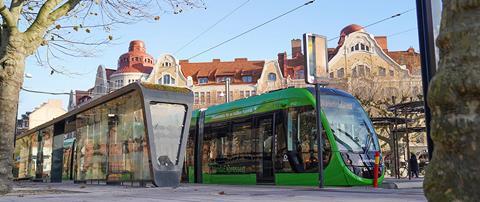
SWEDEN: Lund became Sweden’s fourth city to have a modern tram network on December 13, with the opening of a 5·5 km double-track line connecting the Central station to university facilities and the European Spallation Source.
The line is operated under contract by Norwegian transport group Vy.
The alignment is mostly segregated, replacing sections of busway, and there are nine stops. Trams will run every 20 min off peak and at 7½ min intervals in the peaks, with an end-to-end journey time of 15 min. The capacity is around 1 500 passengers/direction/h, triple that of the bus services it replaces. Services will operate from 05.00 to 00.00, extended until to 02.00 on Saturday and Sunday mornings.
The terminus is immediately in front of the main station entrance, providing easy access for rail commuters to interchange and continue to the city’s higher education and science research facilities. The line serves Universitetssjukhuset (hospital), Lund University (LTH) and Ideon Science Park, before continuing out to the northeast edge of the city to serve a new material sciences campus, with a stop at the MAX IV synchrotron light source and terminating at ESS, the world’s newest neutron spallation source currently under construction and due to begin operations in 2023.
Just beyond the ESS terminus is a small depot housing the fleet of seven low-floor LRVs. The first of these Urbos 33 m long five-section trams was delivered by CAF on July 29 this year, with test running from September 23. They are powered by TSA traction motors.
The project to build the tramway was launched in 2015, with groundbreaking on February 15 2017. The initial scheme envisaged later phases adding a branch southeast to Dalby and an extension south from Central to Staffanstorp, but these plans have been postponed indefinitely.



